Once a year, the people of Luxor, Egypt enjoy a 3-day party celebrating the moulid (birth date) of the 13th century Sufi leader Sheikh Yusuf al-Haggag, who was also known as “Abu al-Haggag”, “father of the pilgrims”.
Over the course of the event, people celebrate with tahtib (martial art) competitions for the men, carnival rides for the children, pilgrimages to the Abu al-Haggag Mosque, Sufi zikrs (rituals), horse racing, and more. The moulid’s final day culminates with the dora, a parade.
The festival occurs in the middle of the Islamic month of Sha’aban, which is the month that immediately precedes Ramadan. The Islamic calendar is lunar, so every year it shifts about 2 weeks compared to the 365-day solar calendar. In 2019 when I was there, the moulid’s Layla Kebira (big night) was on April 19, the night of the full moon. (In 2018, it was April 29.)
The day after the Abu Haggag’s moulid holds its Layla Kebira, the people of Luxor close the festival with the Dora.
Preparing the Site
It’s fun to arrive in Luxor a day or two before the moulid begins so you can see the preparations for it. In the large open area in front of the Luxor Temple, which you can see in the background in this photo, workers erect a framework of poles. Then they hang fabric on them.
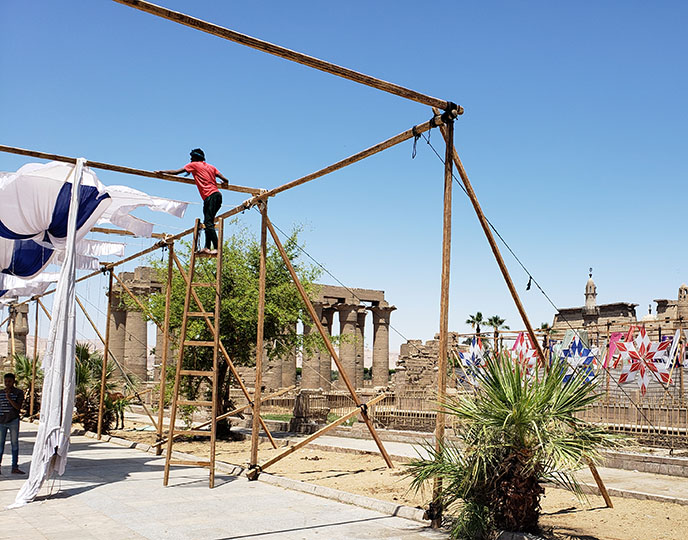
It’s amazing to watch as the man on the ladder does his work. When he needs to move the ladder to a new location, he doesn’t come down to reposition it. Instead, he remains up at the top, and then moves his feet on the rung to make the base of the ladder “walk”. There were no safety harnesses or ropes. I saw a man in Cairo doing the same thing with a ladder 3 years earlier when preparing for the Moulid al-Hussein, so it’s not just Luxor where people do this. At first, I was afraid he’d fall and hurt himself, but then I realized he showed the confidence and skill of a highly experienced person who knew exactly how to do it safely.
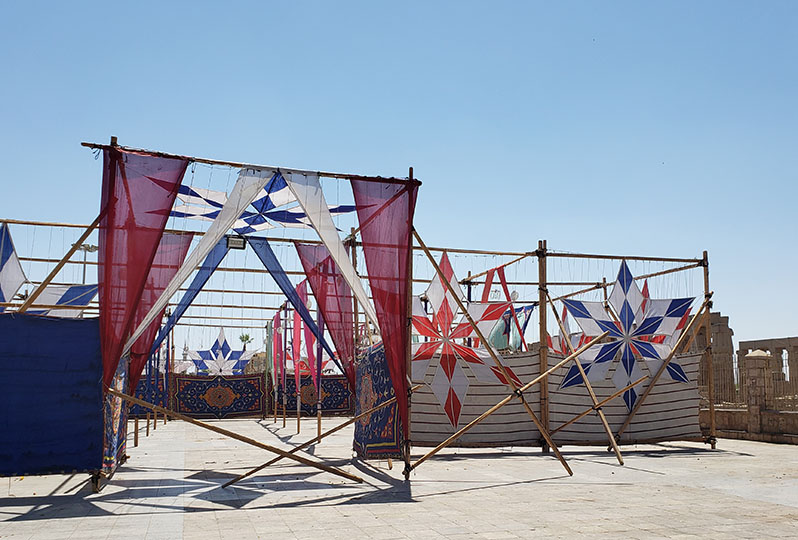
Within a day, the framework was built for the section of the moulid that would host the family entertainment. In the evening, this would fill up with vendors selling street food, toys, and handcrafts. There would also be carnival rides for the children.
The Tahtib Competition
Egyptians are proud of their indigenous martial art, tahtib, which uses long sticks. Tahtib dates back to Pharaonic times, at least 3,000 years ago. Images of men playing tahtib appear on the walls of some tombs, such as this scene which I saw in the tomb of Kheruef (built circa 1300 BCE) in the Luxor area.
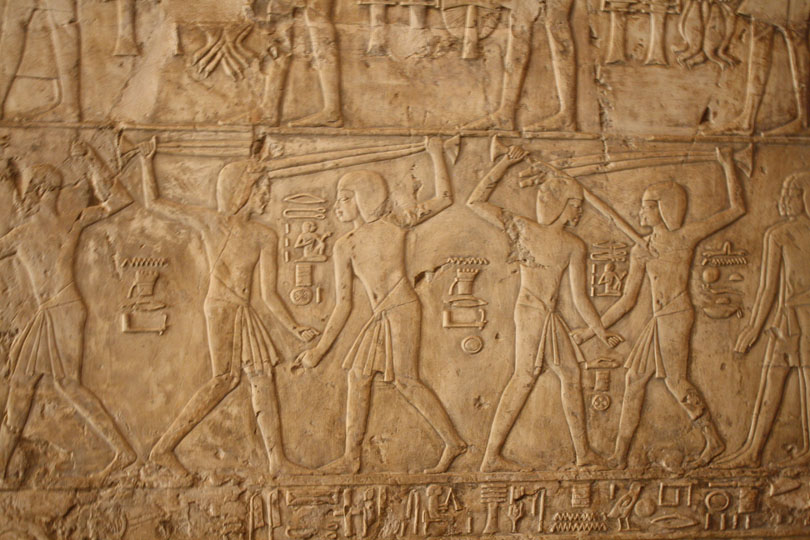
Today, tahtib remains popular as a sport, particularly in Upper Egypt. The first day of the moulid provides a great opportunity to watch a tahtib competition. It’s possible to walk up and join the circle of people watching, then wander away when you’ve seen enough. The best opportunity to get a good view is to show up early, around the time the tahtib tournament begins in late afternoon, before the crowd builds.
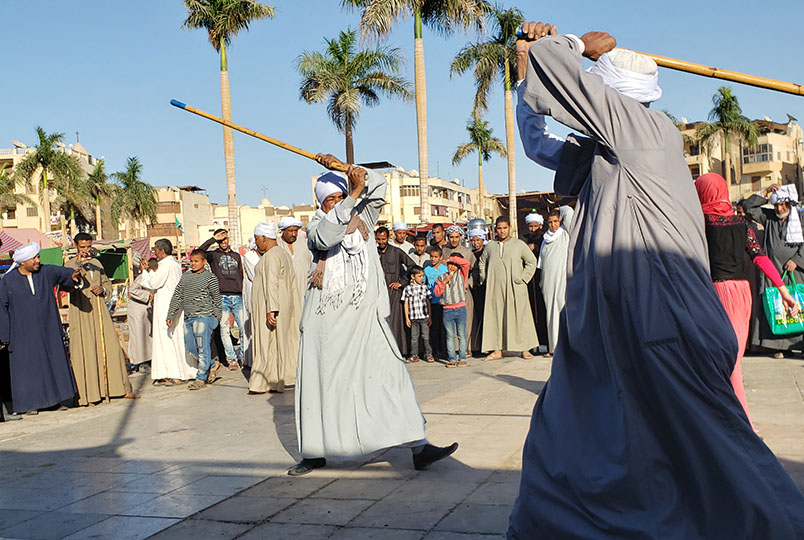
While the combatants take turns facing each other, a band of musicians accompany them playing mizmars, which are double-reeded woodwind instruments that resemble oboes.
The Carnival
The carnival begins after dark on the first evening. There are many vendors, such as this one selling sparkly hats, as well as carnival rides. The vendors start setting up their booths during the afternoon, in preparation for the evening’s festivities.
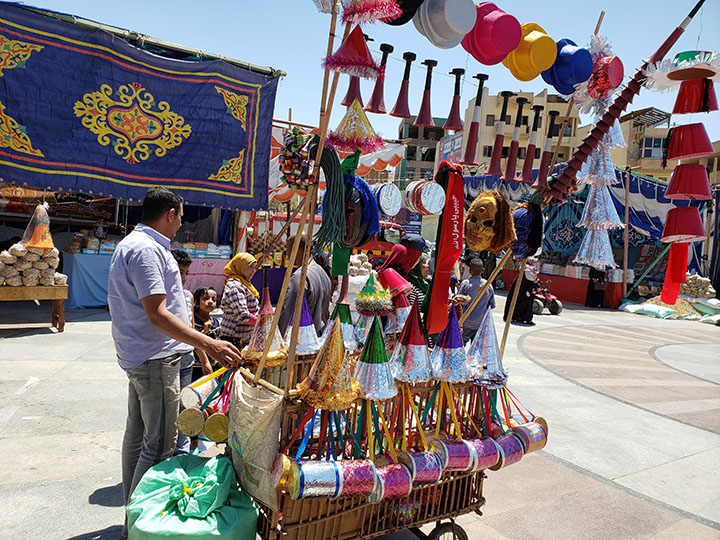
Children enjoy the carnival rides, and the families enjoy exploring what the vendors are offering. As the evening progresses, the men head for the Sufi tents.
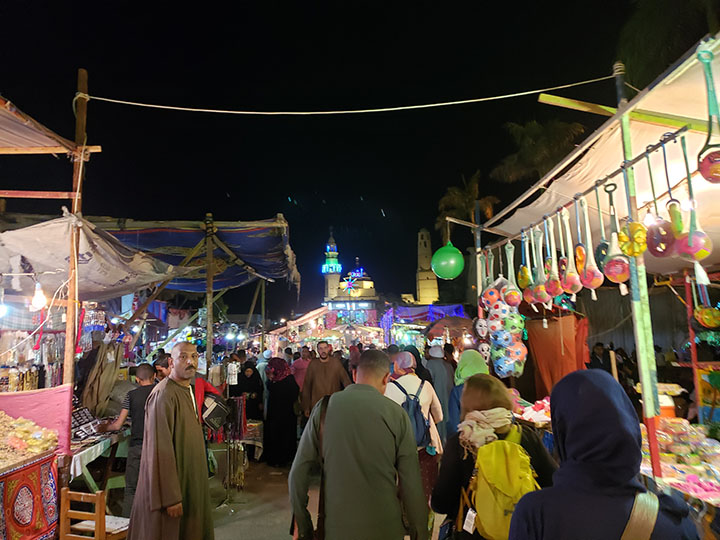
The Sufi tents are large tents erected just for the moulid. Each tent is sponsored by a different large extended family. Each family hires musicians who specialize in Sufi music to perform in their tent for the zikr. Sufism is the mystical branch of Islam, which uses ritual to bring its participants closer to God. Not all sects of Islam approve of Sufism; however, in Egypt, it is very much part of the culture.
The Mirmah
The mirmah occurs on the second day of the moulid. People gather on a large open field to watch horseback riders show off their steeds. The horses race up and down a long open area, galloping as fast as they can, taking pleasure in the speed.
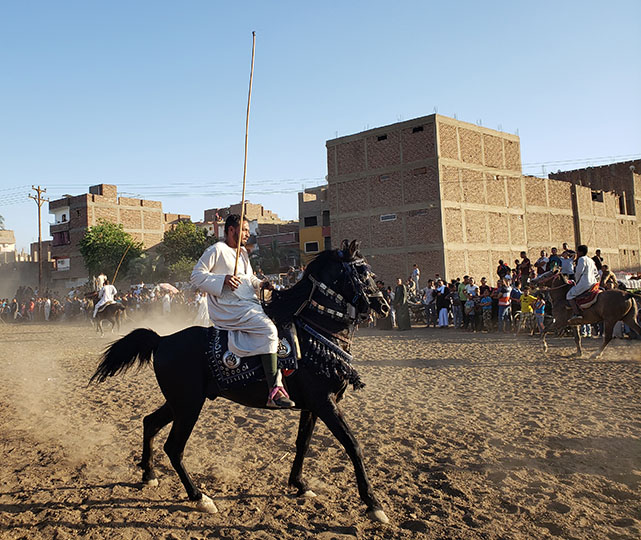
Some of the horseback riders move off to one side of the “race track” to play martial arts with their sticks while on horseback. This photo shows a man holding one of those sticks. Two riders will circle their horses around each other and extend the sticks as if to strike.
The mirmah is very informal. Anybody who wants to can walk up to the field where it is occurring, watch for a while, then leave when ready. There’s no barrier between the observers and the horses. Sometimes the horses get spooked by something and run off course, so it’s a good idea to stay well off on the sidelines, to avoid having a horse run into you!
Layla Kebira
In Arabic, the words “layla kebira” mean “big night”. This is the climax of the Abu al-Haggag moulid. Once again, the carnival is fully operational, and the Sufi tents are all filled with men participating in the zikr. Many people come in to Luxor from neighboring towns for layla kebira, because that is when the most prestigious singers perform in the Sufi tents.
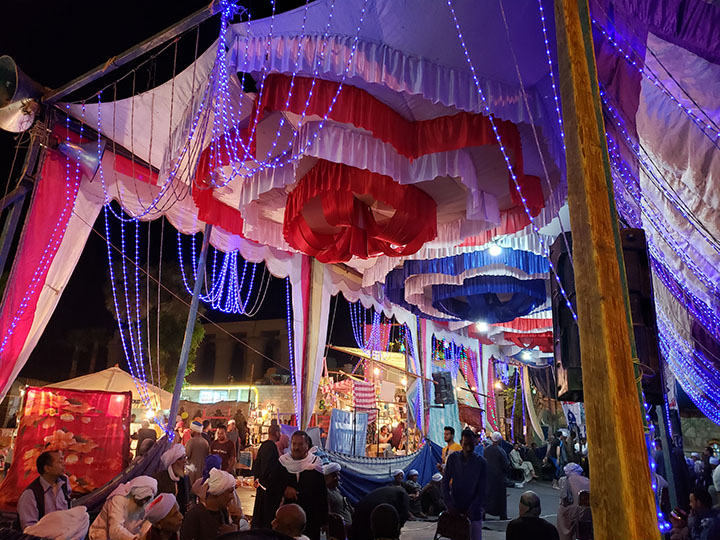
In a zikr, the men move rhythmically together in unison while musicians perform Sufi songs whose lyrics praise God. The movements are repetitive, designed to enable the men to go into trance. These zikrs can continue for many hours, often all night.
Only the male family members participate in the zikrs. Although older boys are allowed to join the circle and do the movements, the participants are primarily adult men. Women will often sit on chairs just outside the tents, socializing with each other and enjoying the beautiful Sufi music. A highlight of the experience for me was sitting next to some women who began a conversation with me. They spoke English well (much better than I speak Arabic), and they made me feel very welcome as part of their group.
The Dora
Although many moulids throughout Egypt feature carnivals, family entertainment, and zikrs, the dora is unique to Luxor’s Abu al-Haggag moulid. It is a parade whose roots lie thousands of years in the past, in Pharaonic times.
The moulid culminates with the dora on its third and final day, following layla kebira. Entries in the parade include camels dressed up in costumes, young men walking together in groups proudly holding their sticks, and vehicles called “boats” that represent local businesses. The dora ends with a group of shrines (see photo below) carried aloft by devotees of the saints they represent.
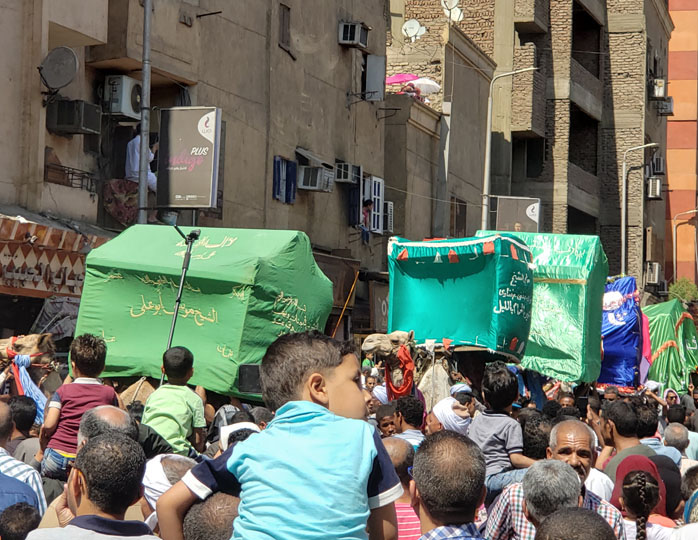
I have devoted a separate blog entry entirely to the dora, because it is such a fascinating event with so much to see. In that separate blog entry, I provide information about the history of the dora, and I include many photos of the modern-day parade.
Once the dora is over, the moulid is over. All that’s left is to disassemble the structures that were erected for it, and clean up the festival area.
Related Articles
Other articles on this blog related to Egypt’s Sufi traditions include: